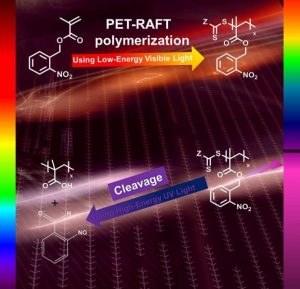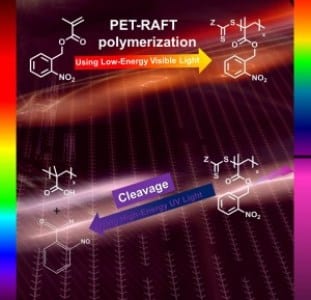Recently, Prof. Cyrille Boyer and his group at the University of New South Wales in Australia have developed a benign synthesis route for a novel controlled polymerization known as photoinduced electron/energy transfer−reversible addition−fragmentation (PET-RAFT) polymerization. This technique is rapidly emerging as a promising tool in polymerizing a wide range of monomers using visible light and near Infrared (from 460 to 900 nm) in the presence of photocatalysts to prepare precise, controlled polymers. Using light to mediate the polymerization offers unique advantages over conventional polymerization methods by performing the reaction at room temperature and avoiding side reactions. Additionally, light as a spatially and temporally controllable external stimulus can be readily tuned and focused to trigger changes in the structure of polymer chains to provide “on-command” drug delivery.

Using light to polymerize a photocleavable monomer
In a new study, which has been published in Macromolecular Rapid Communications, Bagheri and Yeow have introduced this approach for the polymerization of a photoresponsive monomer under visible light. The idea was to employ low energy visible light to polymerize monomers which can be cleaved upon high-energy wavelength radiation (e.g. UV). The authors have successfully polymerized one of the most common photoresponsive monomers, o-nitrobenzyl methacrylate (NBMA), using low energy wavelengths (either yellow or red light). It is the first example of living radical polymerization of photocleavable monomers by a light-mediated polymerization. More importantly, a better control was achieved using visible light regulated polymerization (PET-RAFT) in comparison with conventional thermal living radical polymerization, including RAFT, ATRP or NMP of such sensitive monomers. The results augment further understanding to this polymerization process and show its considerable practical importance in the both field of polymerization and photoresponsive drug delivery systems.

















